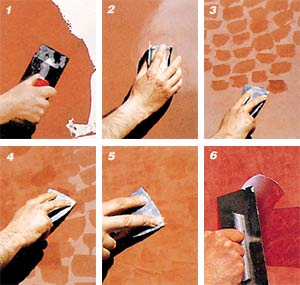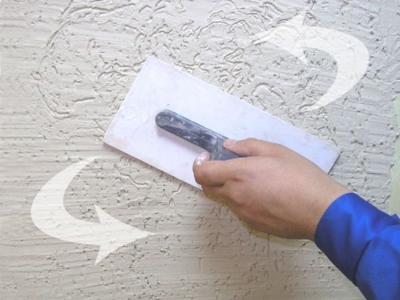Recently, a lot of varieties of finishing wall coverings based on dry mixes have begun to appear. At the same time, if earlier all such products were called putties, today they can carry different names, which are more consistent with their technical characteristics and installation method. Especially stands out among such a variety of textured plaster for the bathroom, which has a stunning appearance and works perfectly in this room.
General characteristics and installation
To begin with, it must be said that all mixtures for this type of premises must have good resistance to moisture and, at the same time, have their own specific structure. Given these features, Venetian plaster is best suited for such a job, since it has several components with different properties.
However, there are other specialized mixtures that can also be used in the bathroom, as they are often used for facade work.

Optimum performance
- First of all, the gypsum plaster used in the bathroom should not absorb moisture. Otherwise, even the most reliable coating of protective mixtures or primers will not be able to withstand its effects. The fact is that ordinary gypsum absorbs liquids very well due to its porous structure.
- It is also necessary that the selected mixture can withstand intense heat and sudden changes in temperature. A fairly large number of different mixtures can be selected to these criteria, since they respond perfectly to the given parameters.

- At the next stage, you need to choose such plaster mixes for the bathroom, which can create a kind of texture. Among all modern finishing mixtures, the Venetian version of the manufacture of coatings is best suited for this, since it allows you to create an imitation of more expensive materials, has a stunning appearance and at the same time tolerates heat and moisture well.
- There are other textured types of materials, but they are all based on creating a kind of relief on the walls. Moreover, during operation in premises of this type, dirt is very often collected in such grooves and depressions, which can cause the appearance of infection and microbes.

- Considering all the necessary properties, most masters, when asked about how to plaster a bathroom, recommend purchasing compositions specially designed for these premises. However, some manufacturers indicate this directly on the packaging.
Advice! When choosing a specific mixture, you should immediately purchase a primer that was developed for this material. This is very important, since some components can react with each other, and some manufacturers, on the contrary, try to achieve such a result, which ultimately becomes the reason for the appearance of unique putties or plaster mixtures.

Mounting
- First of all, it should be noted that the decorative plaster mix for the bathroom must be applied to a relatively flat surface. It should not have potholes, cracks or other defects. The standard permissible level difference should not exceed 2 mm per square meter.
- Given this feature, professional craftsmen recommend making an initial alignment. To do this, you can use ordinary plaster mixtures or cement-sand mortar.

Application of the first forming layer
- After the surface is flat and completely solidified, the installation instructions recommend applying a layer of primer on it, which is selected for the specific type of material. It should increase the level of adhesion of all components and serve as additional protection against moisture.
- Next, take the main component of the plaster mixture, and dilute it in accordance with the recommendations on the package. It is he who serves to create a certain texture or pattern.

- A small amount of dye can be added to the resulting mixture to whiten this element. However, if you plan to create a surface for painting, then this is not worth doing.
- Such plaster is applied with the help, creating a chaotic pattern. In technical terms, we can say that the thickness of a given layer is constantly changing in different parts of the wall. However, you should not create a difference of more than 2 mm.

- After that, let the surface dry and then apply a layer of primer on it with our own hands. In this case, this is especially important, since you will have to work with different substances and in the presence of a large number of drops.
- At the next stage, you need to dilute the finishing material, to which you can also add dye if necessary. It should be noted that most manufacturers produce their products ready for use. This is necessary in order to accurately repeat the design ideas of the company's developers.

- However, it must be said that the price of such materials is quite high and does not always correspond to the quality. That is why professional craftsmen try to purchase dry mixtures or at least compositions without added pigment.
- The coating is applied using a roller to maintain the topography of the surface or using a trowel to level it in accordance with the highest point of the first layer.

- After the second mixture has been applied, some experts recommend re-priming and repeating the operation after 4 hours. However, the layer you create should be minimal.
- Then the surface is treated with a special float with a fine abrasive mesh and primed again. The final coating should not be painted, otherwise the inner layer will disappear. However, if a relief was created, then this procedure is better to carry out.
Advice! There is simply a huge number of different materials and technologies for their installation for creating or plastering. Therefore, their choice must be treated very carefully, having studied in detail all the properties of the selected substance and the technology of its installation on the wall.

Output
By watching the video in this article, you can get more information about such substances and how to install them. At the same time, based on the text set out above, it is worth concluding that the most important thing in this process is the correct choice of finishing material. It is from him that the final appearance and service life of the surface in the room will depend ().
